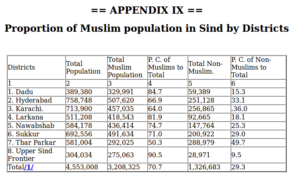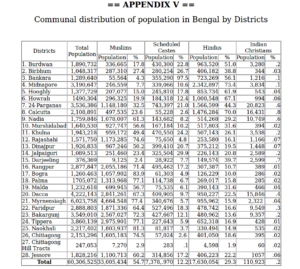I was rifling through Ambedkar’s book on Pakistan (rediscovered it courtesy of Slapstik) and I came across the curious statistic of Sindh’s pre-partition population statistics. I was shocked to see just how high the non Muslim percentage actually was in 1935. The proportion of non-Muslim in Indus province towns is simply astonishing, Karachi & NWFP.

There are 7million Hindus in a global Sindhi population of 26million Sindhis. If that’s true then that means that Hindus are approximately 27%, slightly shy of their 29.3% figure in 1935.
I haven’t bothered doing the same analysis for the Punjabi population because of state adjustments of the Indian Punjab after Partition. Here is Bengal’s data in 1935:

The Bengali Muslim population is estimated to be at 55% in 1935. Presently out of 300mm Bengalis worldwide, 185mm (61%) are estimated to be Muslim.
The caveat is that these 1935 Bengali districts don’t include Sylhet. My rough calculations is that the Sylethi population could potentially increase the 55% Muslim figure in 1935 to as high as 58%.
In conclusion the Hindus & non-Muslims of Bengal and Sindh have been able to maintain their relative strength in population even though the Muslim minorities can be said to be poorer and less educated (especially in the case of Sindh, the Sindhi Hindu diaspora is particularly prosperous). There is also the additional factor that Bangladesh has embarked, quite successfully, on family planning and other social projects.
The Myth of Muslim fecundity may have some basis but it is also heavily exaggerated. In this case Demographics is not Destiny.
Ps:These figures are iffy at best since they rely on Wikipedia; for instance the Sindhi Hindu totals do not add up to 7mm but I’m going on what’s generally available.





